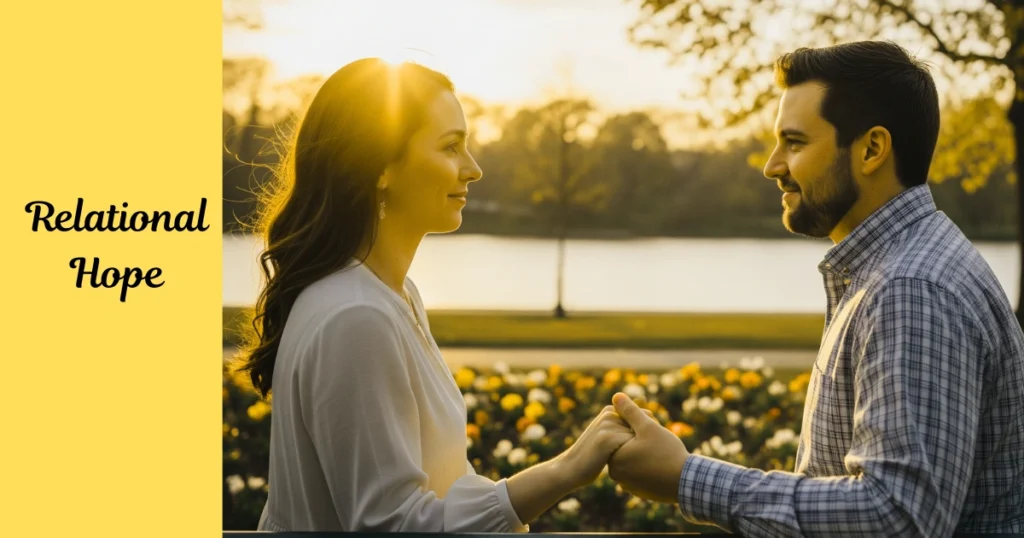Every relationship faces days when life feels heavy, motivation is low, and the future seems uncertain. During these moments, it’s easy to doubt yourself, your partner, or even the strength of your bond. But what if there’s a simple, science-backed skill that can carry your relationship through hard times and make it even stronger?
That skill is called “relational hope.” Unlike regular hope, which is often seen as something you need to find within yourself, relational hope is the belief, energy, and support that you and your partner share and build together.
Key Takeaways
- Relational hope is the shared optimism, effort, and vision that helps couples overcome challenges and grow together.
- Motivation and hope can be lifted by either partner—sometimes, one person’s belief is enough for both.
- Couples who create routines, problem-solve together, and talk about their future are more resilient and satisfied.
- It’s okay to accept support; allowing your partner to “hold the vision” is a strength, not a weakness.
- Building relational hope is an active, ongoing process that anyone can start today.

What is Relational Hope?
Relational hope is the shared sense of optimism, teamwork, and future vision that couples create together. Psychologists now recognize that hope isn’t just an individual trait—it’s a living, breathing part of strong, lasting relationships.
“Hope doesn’t have to begin within you; it can be sparked by the person beside you.”
A 2022 study published in Social and Personality Psychology Compass offers a powerful lens through which to understand these moments as invitations to lean into something called “relational hope.”
Relational hope grows from three main pillars:
- Relational Agency: The shared motivation and effort you both bring to your relationship goals.
- Relational Pathways: The strategies and routines you build together to handle stress and solve problems.
- Relational Aspirations: The dreams and plans you create as a couple for your future.
related read: How to Build Emotional Intimacy in a Long-Distance Relationship
Why is This Skill So Powerful?
1. Relational Agency: Shared Motivation Matters
Motivation in relationships naturally goes up and down. Sometimes, you’re the one carrying the hope. Other times, your partner lifts you up. Studies show that when one partner puts in effort—whether it’s emotional support, spending time together, or working through issues—it boosts both partners’ satisfaction and strengthens the relationship.
Key takeaway:
Even if you are feeling low, allowing your partner to “hold the vision” for both of you is a sign of emotional strength, not weakness.
2. Relational Pathways: Teamwork Gets You Through Tough Times
Hope isn’t just about wishing for better days. It’s about having a plan and knowing how to get through challenges together. Couples who create shared routines—like regular check-ins, walks, or simple habits for resolving conflict—report higher relationship satisfaction.
A 2012 study found that “dyadic coping” (managing stress as a team) is a stronger predictor of relationship happiness than coping alone. Practical teamwork—like problem-solving together—has a bigger impact than just emotional support.
Key takeaway:
Shared strategies and rituals can help you weather life’s storms as a team.
3. Relational Aspirations: The Power of Shared Dreams
Talking about your future together helps anchor your relationship in hope. Whether it’s planning a vacation, dreaming about your future home, or simply saying “we’ll get through this,” these conversations build connection and trust.
Latest research shows that couples who talk about their shared future and offer regular reassurance are more committed and spend more quality time together. These simple actions make your relationship feel safer and more secure.
Key takeaway:
Dreaming out loud and planning together brings new energy and commitment to your relationship.
Statistics & Research
- Couples who practice relational hope report up to 50% higher relationship satisfaction compared to those who don’t.
- Dyadic coping is a stronger predictor of happiness than individual coping strategies (Social and Personality Psychology Compass, 2022).
- Verbal assurances and shared future plans are linked to increased commitment and time spent together (2023 study).
How to Build Relational Hope in Your Relationship
1. Let Your Partner Support You
Allow your partner to carry hope for both of you when you’re feeling down. It’s okay to lean on each other—it’s a sign of true partnership.
2. Create Simple Rituals
Weekly check-ins, evening walks, or “pause” rules before arguments—these small habits become your relationship’s safety nets.
3. Talk About Your Dreams
Discuss your shared goals, plans, and dreams. Even silly or small future plans can reignite hope and connection.
4. Use Positive “We” Language
Say, “We’ll get through this,” or “Let’s figure this out together.” This reminds both of you that you’re a team.
5. Appreciate Each Other Daily
Share something you appreciate about your partner every day. Gratitude boosts hope and trust.
Also read: Insecurities in a Relationship
Quote
“Letting someone believe in you, and in the relationship, when you can’t, is one of the most courageous acts of love.” – Relationship Psychologist
Final Thoughts
Relational hope is the secret ingredient that can uplift your relationship, even on the hardest days. It’s about sharing the load, planning together, and always believing in each other’s ability to grow. Start with small steps—build a ritual, share a dream, and let hope become a team effort.
Ready to strengthen your relationship? Try a simple check-in tonight, or talk about your dreams for the future. Together, you can build the hope that lasts a lifetime.

